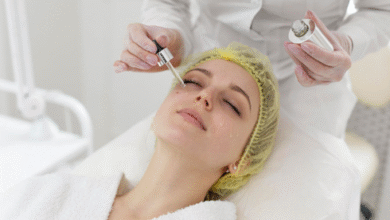The Art and Science of Professional Facials: What to Expect and How to Maintain Results

Professional facials represent a significant enhancement to home skincare routines, offering specialized techniques, professional-grade formulations, and expert assessment unavailable in self-care regimens. Understanding what to expect during these treatments and how to maintain results afterwards maximizes the investment while creating meaningful skin improvement.
Understanding the Professional Facial Difference
Professional facials differ fundamentally from home care through several distinctive elements:
Professional Assessment: Trained estheticians evaluate skin under magnification and specialized lighting, identifying concerns invisible to the untrained eye. This detailed analysis frequently reveals underlying issues developing before becoming visible.
Customized Protocol Selection: Unlike standardized home routines, professional treatments adapt specifically to current skin conditions. This personalization ensures appropriate intensity and focus addressing precise needs rather than generic concerns.
Advanced Technology Access: Professional settings provide technological interventions unavailable for home use, including medical-grade microcurrent devices, LED therapy, ultrasonic exfoliation, and oxygen infusion systems.
Superior Exfoliation Capability: Professional exfoliation achieves depth and uniformity impossible with consumer products. This enhanced cellular turnover creates immediate visible improvement while establishing optimal foundation for subsequent treatment penetration.
Professional-Strength Formulations: Facial treatments utilize higher active ingredient concentrations and specialized delivery systems unavailable in retail channels. The Biologique Recherche collection exemplifies these professional-grade formulations that achieve deeper transformation due to both composition and application expertise.
Types of Professional Facials and Their Benefits
Professional facials encompass diverse categories addressing specific concerns:
Deep Cleansing Facials: Focus on thorough purification, gentle exfoliation, and pore clearing through manual extraction and specialized cleansing methods. These treatments typically involve steam application, cleansing, exfoliation, extraction, and hydration restoration.
Hydrating and Nourishing Facials: Designed for dehydrated, stressed, or mature skin requiring intensive moisture restoration, emphasizing humectants, lipid replenishment, and barrier repair.
Anti-Aging and Firming Treatments: Target structural skin changes through collagen stimulation, muscle tone improvement, and cellular regeneration enhancement, often incorporating specialized massage techniques alongside active ingredients.
Exfoliating and Resurfacing Facials: Emphasize controlled removal of surface cells through chemical, enzymatic, or mechanical methods, revealing fresher skin while triggering repair mechanisms.
Sensitive and Calming Protocols: Specifically formulated for reactive, sensitized, or condition-prone skin, emphasizing inflammation reduction, barrier restoration, and microbiome support.
What to Expect During a Professional Facial
Understanding the typical professional facial process helps manage expectations:
Consultation and Analysis: Quality treatments begin with thorough consultation discussing concerns, goals, medical history, and current product usage, followed by detailed skin analysis under magnification.
Preparation and Cleansing: Treatment typically begins with makeup removal followed by thorough yet gentle cleansing with appropriate products for current skin condition.
Exfoliation Phase: Most facials incorporate some form of exfoliation—whether mechanical, chemical, enzymatic, or ultrasonic—removing surface cells that diminish product penetration.
Extraction (If Appropriate): Many treatments include manual extraction removing impacted material from congested pores using proper preparation, specialized tools, and techniques minimizing trauma.
Treatment Mask Application: Specialized masks deliver concentrated ingredients addressing primary concerns through optimized penetration. Professional masks typically remain significantly more potent than home versions.
Massage Component: Many facials include therapeutic massage addressing lymphatic drainage, muscle tension release, or product penetration enhancement.
Final Product Application: Treatment concludes with appropriate serums, moisturizers, and sun protection preparing skin for environmental exposure while extending treatment benefits.
Home Care Recommendations: Comprehensive treatments include specific recommendations for post-treatment care and ongoing product usage optimizing and extending professional results.
Maximizing Results Through Proper Timing
Strategic treatment timing significantly impacts overall results:
Basic Maintenance Schedule: For general skin health without specific concerns, quarterly treatments (every 12 weeks) generally provide sufficient professional intervention while allowing complete cell turnover cycles between sessions.
Correction-Focused Timing: Addressing established concerns typically requires more frequent initial treatments—often biweekly or monthly—during active correction phase, followed by expanded maintenance intervals once improvement stabilizes.
Age-Based Considerations: Treatment frequency benefits from age-based adjustment, with younger skin (20s-30s) typically maintaining results longer between treatments compared to mature skin (50+) potentially requiring more frequent intervention.
Seasonal Adjustment: Many skin specialists recommend slightly increased frequency during seasonal transitions when skin typically experiences stress from environmental changes.
Special Occasion Preparation: When preparing for significant events, optimal timing places treatments 3-5 days before the occasion, allowing any potential post-treatment sensitivity to resolve while maintaining peak results.
Post-Treatment Care for Extended Results
How skin is treated following professional facials significantly impacts both immediate recovery and long-term benefit duration:
First 24 Hours: Immediately following treatment, avoid active ingredients (retinoids, alpha/beta hydroxy acids, vitamin C), physical exfoliation, makeup application, excessive heat exposure, and direct sun exposure. Focus instead on gentle cleansing and intensified hydration.
Days 2-7: As initial sensitivity resolves, gradually reintroduce regular routine components while monitoring skin response. This period is ideal for intensive hydration and nourishment rather than aggressive active ingredients.
Hydration Maintenance: Professional treatments often trigger increased cell turnover temporarily elevating transepidermal water loss. Compensate through consistent hydration to prevent dehydration that could compromise results.
Sun Protection Vigilance: Following professional treatments, diligent sun protection becomes even more critical due to potential increased photosensitivity, particularly following exfoliating treatments.
Integrating Professional Care with Home Routines
The most effective skincare approach integrates professional treatments with consistent home care:
Treatment-Compatible Products: The most supportive home routine utilizes products compatible with professional treatments, ideally from lines developed specifically for integrated professional/home protocols.
Professional Guidance Implementation: Rather than viewing recommendations as optional additions, consider professional product suggestions as essential prescriptions extending treatment benefits.
Treatment Preparation: In days preceding scheduled treatments, modify home routines to optimize professional results. Typically, discontinue exfoliating products 48-72 hours before appointments, increase hydration support, and avoid potential sensitizing ingredients.
Long-Term Partnership Perspective: View the professional/client relationship as ongoing partnership rather than occasional service, with regular communication regarding routine adjustments, product responses, and changing concerns.
This integrated perspective transforms both elements from separate activities to coordinated system, with professional treatments providing periodic intensive intervention while home care maintains and extends these results through daily support.


